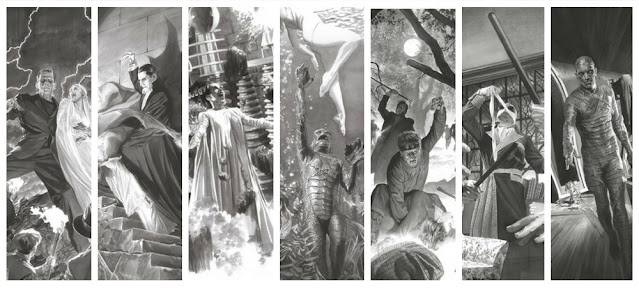I had the distinct feeling after watching The Mummy’s Hand that I was about to forget everything I had seen. Never mind that the film is only 67 minutes long, half of which is astoundingly boring; the half that is interesting is wholly generic and entirely unmemorable. It’s a far cry from the Boris Karloff original and an even further cry from 1999’s The Mummy (which I contend is not just the best mummy movie ever made but one of the best adventure movies, period).
Archaeologist Steve Banning (Dick Foran) and his assistant Babe Jenson (Wallace Ford) think they’ve stumbled upon the last clue to the location of Princess Ananka’s tomb. Initially discouraged by Professor Andoheb (George Zucco), Steve and Babe set off in search of their own funding, which they find in magician-cum-investor Tim “Solvani” Sullivan (Cecil Kellaway) and his daughter/assistant Marta (Peggy Moran). What they don’t know is that Andoheb is secretly the high priest of an order devoted to protecting Ananka, and this priest has a mummy (Tom Tyler) at his beck and call.
As I’m watching the Universal Classic Monster movies, it’s been fun to notice places where tropes were born, moments when story beats become ossified into canonical necessity. In the case of the Mummy films, I’ve been noticing echoes with the Stephen Sommers Mummy, and The Mummy’s Hand has those in spades – a down-on-his-luck adventurer, affluent investors, superstitious local diggers, a museum curator in league with a secret society. For being only the second Mummy movie, there’s a surprising amount of formula already at play in The Mummy’s Hand, even as it differentiates itself from the 1932 original by locating a solid half of the film to the archaeological dig site.
When the film gets to the dig site, the real mummy action kicks in, and The Mummy’s Hand is at a minimum watchable. That action is horribly cliché, and there’s a surprising lack of urgency despite the fact that the mummy Kharis is methodically killing off protagonists tent by tent over the course of what seems to be a single night. Having said that, though, there’s a certain engagement to be gained simply by having a supernatural creature skulk through your film and do his master’s dark bidding, and I have to say that there’s something charming about seeing the archetypal mummy action play out. Unlike Karloff’s Imhotep, Kharis is a silent and lumbering brute, lurching his way toward his victims, and makeup artist Jack Pierce adds another visual stunner into his repertoire. If nothing else, this mummy looks good.
“Watchable at best” is certainly damning with faint praise, and it’s a real wonder if audiences even make it that far. The first half-hour of the film is interminable in dragging out its exposition; The Mummy’s Hand opens with two old men droning on about mythic backstory before one expires, perhaps from boredom. Then the film sets up a long and uninteresting plot in which Steve Banning fundraises for his expedition before falling in with a magician who never does much magic beyond his introduction. (You’d hope, if Solvani is Chekhov’s Magician, he’d do a bit of prestidigitation to save the day. No such luck here.) These B-movie shenanigans truly diminish the film’s potential for horror to the point where you almost expect the gumball machine from Mystery Science Theater to pop up and start riffing on how dull the film is.
Often the best thing we can say about a bad Universal Monster film is that they rarely overstay their welcome. The Mummy’s Hand is brief, but it’s a slog, exacerbated by subpar acting that’s both monotonous and overly campy. Wallace Ford gets a few chuckles in as a Lou Costello type, though for comic relief he’s wildly out of place in the brand of monster movies Universal had perfected by 1940. The rest of the cast are the very definition of serviceable though largely indistinguishable from other versions of the same archetypes. Even Tom Tyler as Kharis is a bit of a snooze, and perhaps I was so desperate for something engaging that my first glimpse of a mummy got me to sit up and say, “I’ll take it.” But Kharis himself lacks any agency in the film; he’s at the mercy of Andoheb and his mystical tana leaves, which reanimate the mummy and set him off into the night. There’s a half-baked suspense plot about what might happen if Kharis gets his hands on an infinite supply of tana leaves, but none of the protagonists knows about this, so the net effect of anticipation is a wash.
Ultimately, The Mummy’s Hand is an exercise in unmet expectations and settling for the first gruesome creature to shamble your way. It’s dull and (pardon the pun) lifeless, a reanimated clone of The Mummy drained of its excitement and fueled by the sort of scripting that might fit better on an episode of Svengoolie. Even with a runtime of little more than a hour, as Universal Monster sequels go, The Mummy’s Hand is a bust.
The Mummy’s Hand is not rated. Directed by Christy Cabanne. Written by Griffin Jay and Maxwell Shane. Starring Dick Foran, Peggy Moran, Wallace Ford, Eduardo Ciannelli, George Zucco, Cecil Kellaway, and Tom Tyler.
Tune in tomorrow for Transylvania Tuesday, with Drácula (1931) starring Carlos Villarías and Lupita Tovar.
Next week for Mummy Monday, enter The Mummy’s Tomb (1942) starring Lon Chaney Jr.



No comments:
Post a Comment